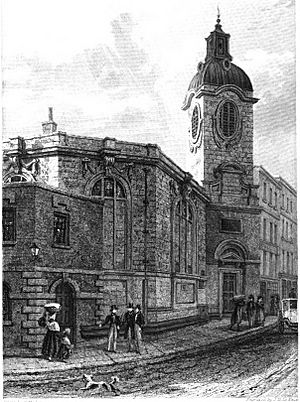St Benet Fink facts for kids
St Benet Fink was a historic church in the City of London. It stood on what is now Threadneedle Street. First mentioned in the 1200s, the church was destroyed in the Great Fire of London in 1666. It was then rebuilt by the famous architect Sir Christopher Wren. However, this new church was taken down between 1841 and 1846.
Quick facts for kids St Benet Fink |
|
|---|---|
 |
|
| Location | London |
| Country | United Kingdom |
| Denomination | Anglican |
| Architecture | |
| Architect(s) | Christopher Wren |
| Style | Baroque |
| Demolished | 1846 |
Contents
A Look Back: Church History
What's in a Name?
The name 'St Benet' is a short form of 'St Benedict'. Before the Great Fire of 1666, London had four churches named St Benet. The earliest record of this church dates back to 1216. However, a 10th-century cross found nearby suggests it might have been built even earlier, perhaps in Saxon times.
The "Benedict" in St Benet Fink refers to two important figures:
- Benedict Biscop: An Anglo-Saxon founder of Jarrow Priory in the 600s.
- Benedict of Nursia: The founder of Western monasticism in the 500s.
The "Fink" part of the name comes from Robert Fink (also known as Finch). He was a generous person in the 1200s who paid to have the church rebuilt. Finch Lane, a street near Threadneedle Street, is also named after his family.
The Great Fire and Rebuilding
St Benet Fink was one of 89 churches destroyed in the terrible Great Fire of London in 1666. Rebuilding started quite quickly in 1670. A generous donation of £1000 from George Holman helped a lot. In return, he was given special seats and a place in the church's burial area. The church and its tall steeple were finished in 1675. The total cost was £4129.
Famous Baptisms
On April 9, 1801, John Henry Newman was baptised at St Benet Fink. He later became a very important religious leader known as a cardinal.
Why Was the Church Demolished?
In 1838, the Royal Exchange, a famous building nearby, also burned down. To make the area around the Royal Exchange better, the City of London decided to take down St Benet Fink's tower and use its churchyard. They also planned to demolish another nearby church, St Bartholomew-by-the-Exchange.
Even though many churches were demolished in London over the next century, this decision caused protests in 1840. People like Edward John Carlos and the local church members spoke out. However, the Bishop of London supported the demolition because there were many other churches close by.
The first part of the church was taken down in 1842. A new entrance was made in the remaining part. But this wasn't good enough. So, the City asked for permission to demolish the rest of the church. This was approved, and the entire church was taken down in 1846.
The St Benet Fink parish was then joined with the parish of St Peter le Poer. The money from selling the church site was used to build a new church, St Benet Fink Church, Tottenham, in a different part of London.
Today, an 8-story office building stands on the old site of St Benet Fink church. It was completed in 1991.
Church Architecture
Wren's Unique Design
The original church before the Great Fire was shaped like a rectangle. After the fire, part of the church's land was used to make Threadneedle Street wider. This left an unusual shape for the new church building.
Sir Christopher Wren designed the new St Benet Fink with a unique ten-sided (decagonal) shape. On top of this ten-sided base, he placed an oval dome with a small tower called a lantern. Six arches inside the church supported this dome. The church also had two aisles with arched ceilings.
Some historians believe Wren might have been inspired by Bernini's Sant'Andrea al Quirinale church in Rome. Wren had studied Bernini's drawings when he visited Paris in 1665.
Building Materials and Tower
The church walls were made of brick and rubble, covered with Portland stone. For much of its history, other buildings surrounded the church.
The church tower was attached to the west side of the ten-sided building. It had a square dome with a bell cage on top. Uniquely for a Wren church, it had a ball and cross instead of a weather vane. The tower, including its steeple, was 110 feet tall.
Images for kids


